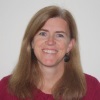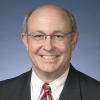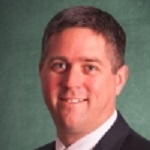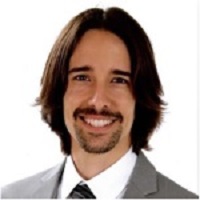In October 2016, Susan Burmeister, PE, from S2B Consulting Engineers, PLLC, presented Advanced Topics in Composite Steel Beam Design. She nominated Bridges to Prosperity (http://www.bridgestoprosperity.org/) for the SEU Speaker Inspires donation of the month.
According to their website, “Bridges to Prosperity envisions a world where poverty caused by rural isolation no longer exists. Our programs provide access to healthcare, education and markets by teaching communities how to build footbridges over impassable rivers, in partnership with organizations and professionals. We prove the value of our work through a commitment to the community and its bridge that lasts long after the opening celebration.”
Thank you, Susan, for helping structural engineers with your SE University session, and for your designation of Bridges to Prosperity as our SEU Speaker Inspires Organization of the Month!
SE University began the SEU Speaker Inspires program in 2015 as a way to “pay it forward”, enabling our speakers to designate a charity/organization of their choice for SE University to make a donation to help improve our world.
28 Feb 2017
Have a Knack for Networking
The term ‘networking’ can elicit varying reactions among engineers. You may think of networking opportunities being available through local chapters of structural or civil engineering societies, technical conferences, or building construction associations. Some engineers react with excitement at the thought of networking at these events, while others may cringe at the thought. Some may even consider networking a complete waste of time. However, what if we challenge ourselves to think about networking in a different light?
In an article in Forbes Magazine, Andrew Vest outlines How to Network the Right Way, and includes several tips to be successful at your next networking opportunity. His advice on the subject suggests the key is to consider networking as an opportunity to help others rather than for self-gain.
Often times, engineers will only branch out to network when they are in need of something, such as developing new clients for the firm they work for, looking for a new job, or growing their own business. What if instead, you challenged yourself to get more involved and offer your talents and knowledge to help benefit the group?
One key idea presented in the article is that the right way to approach networking is to start before you need anything. Begin by changing your motives, and aim to enjoy people that share your same passions. Mr. Vest comments that the most successful networkers learn to listen and figure out who they can connect with others to be a benefit to the group, without striving for personal gain. Entering a networking opportunity with the goal of learning more about others and their businesses so that you might be able to help them can also lead to better relationships and growth within your own business.
If networking has never been ‘your thing’, perhaps approaching it in a different attitude may help ease your discomfort. The strategies outlined by Mr. Vest can certainly be employed at your next meeting or event, and you might find you enjoy networking more when your focus turns to others first.
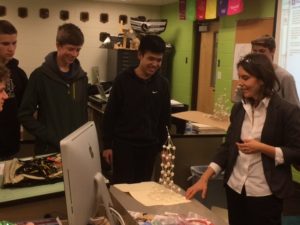 SE Solutions recently helped organize a week long course called “Explore Engineering” at a Michigan High School. The course gave students an opportunity to get an insight into various disciplines of engineering, including Civil and Structural Engineering. Several structural engineers gave presentations to the students with an opportunity for “hands on” demonstrations also, including:
SE Solutions recently helped organize a week long course called “Explore Engineering” at a Michigan High School. The course gave students an opportunity to get an insight into various disciplines of engineering, including Civil and Structural Engineering. Several structural engineers gave presentations to the students with an opportunity for “hands on” demonstrations also, including:
AnnMarie Garko-Hill, PE: Senior Technical Manager of Structural Engineering Software at Bentley Systems. (www.Bentley.com) AnnMarie gave a presentation on Structural Engineering and then had students build the tallest building they could out of marshmallows and toothpicks.
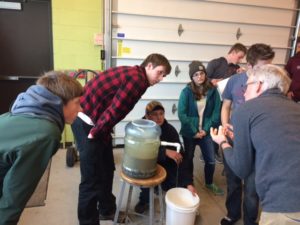
Bob Johnson, PE, President, Structural Solutions Studio, Jenison, MI. Bob provided further insights into Structural Engineering for the students. He also was able to include information on the 20 trips he’s made to Rwanda for “20 Liters” to help bring clean drinking water to Rwanda. Bob was able to bring equipment for the students to build their own bio-sand filters.
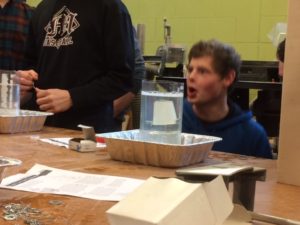 Sue Khalifah, SE, PE; Student Experience Director, Lyles School of Civil Engineering, Purdue University. Sue gave an overview of Civil Engineering and then had a hands on buoyancy experiment for the students.
Sue Khalifah, SE, PE; Student Experience Director, Lyles School of Civil Engineering, Purdue University. Sue gave an overview of Civil Engineering and then had a hands on buoyancy experiment for the students.
Thank you to AnnMarie, Bob, and Sue for investing their time in helping high school students learn about engineering!
In February 2017, Duane Miller, PE, from the Lincoln Electric Company, presented Welding Myths that Structural Engineers Need to Know About. He nominated The City Mission in Cleveland (https://www.thecitymission.org) for the SEU Speaker Inspires donation of the month.
Duane shared why he chose The City Mission: “An icon in the welding world, Mr. Omer W. Blodgett passed away in January 2017 at the age of 99. In his honor, his family has requested donations be made to the Cleveland City Mission, an organization that has for over a century provided help and hope to Cleveland’s hurting and homeless; in his honor, I’d like this SEU donation to be made. Mr. Blodgett’s was a longtime supporter of not only the Cleveland City Mission, but of similar organizations in other major cities throughout the US. To me, Mr. Blodgett was my mentor. In an unselfish way, he wanted me to “take over his work” and he showed me how to do so. I’ll never replace him—no one will—but he taught me how to continue to do what he did. He was an exceptional engineer, a tremendous teacher and an consistent Christian, leaving a legacy and an example for all of us to model.”
Thank you, Duane, for helping structural engineers with your SE University session, and for your designation of The City Mission in Cleveland as our SEU Speaker Inspires Organization of the Month!
SE University began the SEU Speaker Inspires program in 2015 as a way to “pay it forward”, enabling our speakers to designate a charity/organization of their choice for SE University to make a donation to help improve our world.
In January 2017, Matthew Rechtien, PE, Esq., a member of the law firm of Bodman PLC, presented A Case Study, and Legal Perspectives, on Engineering Ethics: The Kansas City Hyatt. He nominated the David and Maxine Fowler Endowed Excellence Fund at the University of Texas at Austin(http://endowments.giving.utexas.edu/page/fowler-david-maxine-exc-fnd-caee/4886/) for the SEU Speaker Inspires donation of the month.
Matthew shared why he chose the David and Maxine Fowler Endowed Excellence Fund: “Dr. Fowler, with the support of his wife, Maxine, has been a mentor, advocate, and friend for twenty years. As a professor at the University of Texas for half a century, he has touched the lives of literally hundreds of other engineering students, engineers and others in a similar way. Dr. Fowler is a gentleman and scholar in every sense of those words. I am humbled to be able to contribute, in any way (but especially by, as he did, teaching my fellow engineers), to his legacy, including the David and Maxine Fowler Endowed Excellence Fund.”
Thank you, Matthew, for helping structural engineers with your SE University session, and for your designation of the David and Maxine Fowler Endowed Excellence Fund as our SEU Speaker Inspires Organization of the Month!
SE University began the SEU Speaker Inspires program in 2015 as a way to “pay it forward”, enabling our speakers to designate a charity/organization of their choice for SE University to make a donation to help improve our world.
27 Jan 2017
Desk Organization for Maximum Productivity
Take a look at your desk…. Is it helping or hindering your ability to have the most productive day possible? Do you waste time searching for those submittals from last week that the contractor is asking about on the phone, as you are frantically searching under shop drawings and through piles of mail? Basic organization at work is essential to maximum productivity. At times, even the most Type A person can get a bit disorderly throughout the day, but following these 5 tips can help you get organized and stay organized, so that your productivity can remain top notch throughout the week:
- Start with a deep clean. Take everything off of your desktop area and start fresh. Clean, dust and sanitize your work environment. Then, design a quick setup of your computer and most used office supplies, so that you have them at your fingertips throughout the day. Separate all paperwork into 3 piles: trash, items that need to be filed, and items that require action.
- Create a box system that works for you. You may only need an incoming and outgoing mail box, or you may need additional box trays for items on hold, a designated area for shop drawings, or current project files that need to be within reach. Set up specific areas for each type of incoming paper, and keep up with proper redistribution of these materials as they come into your office. Filter all of the paperwork you removed from your desk into these new designated box trays or areas.
- Minimize personal items in your office, especially items that occupy valuable desk space. Consider moving pictures to hang on the wall rather than sit on your desk, and eliminate any items that have collected dust, as they clearly are not everyday essentials.
- Keep current projects in a separate file drawer close to your desk and archive projects that are complete. Keep large scale drawings rolled and standing vertically in a box, if possible, to free up desk space.
- Schedule time each week to maintain organization. The time it takes to keep organized is less than the time wasted from being unorganized! Before leaving for the day or weekend, be sure to clean up and distribute paperwork as needed, so you can start each day with a focus on maximum productivity.
04 Jan 2017
Specifications for Steel Castings
Have you been involved in a project with extensive architecturally-exposed steel connections or complex geometric constraints? Or, have you ever considered using standardized steel castings to improve seismic resistance in braced frame construction? Structural steel castings can be a benefit in all of these situations, but may not be as familiar to most engineers as traditional designs.
In the November 2016 SE University Supplemental Session, Carlos de Oliveira, M.A.Sc.,P.Eng., from Cast Connex Corporation, gave a talk on Structural Applications for Steel Castings. During this lunch and learn presentation, Carlos gave a brief history of the use of steel castings, explained how they are manufactured, and discussed when steel castings can be used to benefit the structural design. Both standardized and custom castings can be useful in solving complex structural geometry and connections, and are typically more aesthetically pleasing for the architect. Some of the structural designs shown in his presentation were truly impressive and may inspire some ingenuity in your next design.
Using steel castings may be new to some structural engineers, however, Carlos gave some tips on specifying castings in the contract documents. For custom castings, the engineer and architect need to provide the overall dimensions, configuration, and relationship to other structural and architectural components on the drawings. Then, the engineer should include additional requirements within the specification to delegate the structural design responsibility to the casting supplier by outlining the structural performance requirements (ie. structural loading, structural connection to the castings, and machining requirements), as well as architectural performance requirements (ie. surface finish, and AESS welding requirements).
Carlos also provided some resources for using templates for these specifications for custom and standardized steel castings. These templates are a great tool to get started in specifying structural steel castings for your next project that includes complex geometry or architecturally exposed steel. Click on the slide below to view an excerpt from the specs or click visit http://www.arcat.com/arcatcos/cos48/arc48577.html to view example specs and catalogs for various steel casting connections.
In December 2016, Kimberley Robinson, PE, SE, from SunSteel LLC, gave a talk on Structural Irregularities per the ASCE7-10 Seismic Design Requirements. She chose the Structural Engineers Association of Utah Scholarship Program (http://www.seau.org/) for the SEU Speaker Inspires donation of the month.
Kim shared why she chose the SEAU Scholarship Program: “I think that it is very important to support young and talented would-be engineers and bring them closer to their goal of a college degree and a rich and rewarding career.”
Thank you, Kim, for helping structural engineers with your SE University session, and for your designation of the SEAU Scholarship Program as our SEU Speaker Inspires Organization of the Month!
SE University began the SEU Speaker Inspires program in 2015 as a way to “pay it forward”, enabling our speakers to designate a charity/organization of their choice for SE University to make a donation to help improve our world.
In November 2016, Carlos de Oliveira, M.A.Sc., P.Eng., from Cast Connex Corporation, gave a talk on Structural Applications for Steel Castings. He chose the École Lakay Project in Haiti (http://www.cca-acc.com/cca/ecole-lakay/) for the SEU Speaker Inspires donation of the month.
Carlos chose the École Lakay Project because his company has previously donated to the design and re-construction of this project after the 2010 earthquake destroyed this trade school in Port-au-Prince. The new facility includes state-of-the-art seismic-resistant High Strength Connectors, made by Cast Connex, which have been fabricated and erected, but the project needs additional funding to complete the non-structural components of the building through Builders without Borders and the Canadian Construction Association. Besides teaching the students a trade, the school also provides basic necessities and will be able to accommodate 200 students upon completion.
Thank you, Carlos, for helping structural engineers with your SE University session, and for your designation of the École Lakay Project as our SEU Speaker Inspires Organization of the Month!
SE University began the SEU Speaker Inspires program in 2015 as a way to “pay it forward”, enabling our speakers to designate a charity/organization of their choice for SE University to make a donation to help improve our world.
28 Nov 2016
Utilizing Vacation = Increased Productivity
The average American employee leaves over 3 days of paid vacation unused, despite the evidence that spending time away from work is beneficial for both the employee and employer. Spending time away from work actually increases your productivity while at work. Research has shown this to be the case, and it makes logical sense. We tend to be more focused and driven to complete tasks in a timely manner when we know a vacation day is coming and we have less time to complete our workload. We spend less time socializing or wasting time on smart devices or social media, rather we work tirelessly to ensure we wrap things up before leaving on vacation. Research also shows spending time away from work decreases stress, improves health, boosts the office morale and creates a more loyal employee.
So why do workers continue to leave unused vacation on the table? Heavy workloads and often self imposed pressures to not take time off tend to be the biggest contributors. With the holiday season at our doorstep, may this serve as a good reminder of the benefits of using your vacation time with those that matter most. A healthy and well-rested employee is of greater value to their family and their employer. So, enjoy your time away and return with renewed energy and determination to be a benefit to your employer!

